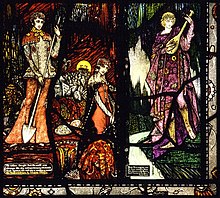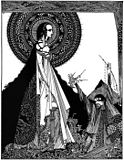Harry Clarke
Harry Clarke | |
|---|---|
Arts and Crafts | |
| Spouse | Margaret Clarke |
Henry Patrick Clarke
His work was influenced by both the
Early life
Henry Patrick Clarke was born 17 March 1889, younger son and third child of Joshua Clarke and Brigid (née MacGonigal) Clarke.[1] Joshua Clarke was a church decorator who moved to Dublin from Leeds in 1877 and started a decorating business, Joshua Clarke & Sons, which later incorporated a stained glass division. Through his work with his father, Clarke was exposed to many schools of art but Art Nouveau in particular.[citation needed]
Clarke was educated at the Model School in Marlborough Street, Dublin and
At the art school in Dublin, Clarke met fellow artist and teacher, Margaret Crilley.[1] They married on 31 October 1914 and moved into a flat at 33 North Frederick Street. In subsequent years the Clarkes lived in various locations in Dublin, including a semi-detached house in Cabra in which Margaret Clarke painted her husband at work. The Clarkes had three children, Michael, David, and Ann.[1]
Career

Book illustration
Clarke briefly moved to London to seek work as a book illustrator. Picked up by London publisher
Clarke was commissioned by Committee of the Irish National War Memorial
Difficulties with these projects made Fairy Tales by Hans Christian Andersen his first printed work, in 1916. It included 16 colour plates and more than 24 halftone illustrations. This was followed by illustrations for an edition of Edgar Allan Poe's Tales of Mystery and Imagination: the first version of that title was restricted to halftone illustrations, while a second with eight colour plates and more than 24 halftone images was published in 1923.[5]
This 1923 edition made his reputation as a book illustrator, during the golden age of gift-book illustration in the first quarter of the twentieth century. It was followed by editions of The Years at the Spring, with 12 colour plates and more than 14 monotone images; (Lettice D'Oyly Walters, ed., 1920), Charles Perrault's Fairy Tales of Perrault, and Goethe's Faust, with eight colour plates and more than 70 halftone and duotone images (New York: Hartsdale House, 1925). The last of these is his most famous work, prefiguring the imagery of 1960s psychedelia.[5] Two of his most sought-after titles are promotional booklets for Jameson Irish Whiskey: A History of a Great House (1924, and subsequent reprints) and Elixir of Life (1925), which was written by Geofrey Warren. His final book, Selected Poems of Algernon Charles Swinburne, was published in 1928.[1]
Stained glass

Clarke produced more than 130 windows, he and his brother Walter having taken over his father's studio after his death in 1921.
Clarke's stained glass work includes many religious windows, but also much secular stained glass. Highlights of the former include the windows of the
Later years and death

Both Harry and his brother Walter were plagued with ill health, in particular problems with their lungs.[5] Clarke was diagnosed with tuberculosis in 1929, and went to a sanatorium in Davos, Switzerland.[1] Fearing that he would die abroad, he began his journey back to Dublin in 1931, but died on 6 January 1931 in Chur where he was buried. A headstone was erected; but local law required that the family pledge to maintain the grave 15 years after the death. This was not explained to the Clarke family and Harry Clarke's remains were disinterred in 1946 and reburied in a communal grave.[1][9]
Legacy
In 2019 a bridge in Cabra, Dublin, was renamed "Harry Clarke Bridge" in his honour.[10]
Gallery
Stained glass windows
-
Saint Gobnait, Honan Chapel, Cork, 1916
-
St Anne and Mary, St Mel's Cathedral, Longford
-
Chapel of the Sacred Heart, Dingle, The Baptism of Jesus, 1922–24
-
"Vision of Bernadette at Lourdes", Church of Saint John the Baptist, Duhill, County Tipperary
Illustrations
-
Queens whose finger once did stir men ("The Playboy of the Western World"), 1917
-
Illustration for Edgar Allan Poe's "Ligeia", 1923
-
The Fairy, from Fairy tales of Charles Perrault, 1922
-
The Colloquy of Monos and Una, Edgar Allan Poe series, 1923
-
Faust, page 2, 1925
Works
As illustrator
- Poe, E. A. - Tales of Mystery and Imagination, George Harrap, London, 1919
- Walters, L. - The Year's at the Spring, George Harrap, London, 1920 The Year's at the Spring via HathiTrust
- Perrault, C. - The Fairy Tales of Charles Perrault, George Harrap, London, 1922
- _____ Ireland's Memorial Records 1914-1918, Maunsel and Roberts, Dublin, 1923
- _____ Jameson The Origin of John Jameson Whiskey, Jameson 1924
- ____ The Elixir of Life Jameson 1925
- Goethe, J. W. von - Faust, George Harrap, London, 1925
- Swinburne, A. C. - Selected Poems of Charles Swinburne, John Lane, London, 1928
See also
- An Túr Gloine, stained glass firm with which Clarke was associated
- Harry Clarke - Darkness In Light
References
- ^ a b c d e f g h i Andrews, Helen; White, Lawrence William (2009). "Clarke, Harry (Henry Patrick)". In McGuire, James; Quinn, James (eds.). Dictionary of Irish Biography. Cambridge: Cambridge University Press.
- ^ The Irish genius behind the world's most iconic stained glass windows, Irish Central, 5 June 2016.
- ^ a b "About Harry Clarke (1889-1931)". The Hugh Lane Gallery. Retrieved 10 May 2015.
- JSTOR 41809143.
- ^ ISBN 9781845889715.
- ^ "Ireland's memorial records 1914-1918: being the names of Irishmen who fell in the Great European War, 1914-1918. Volume five. Ker to M'Gil". Digital Collections: The Library of Trinity College Dublin. Retrieved 2 February 2022.
- ^ Helmers, Marguerite (12 December 2015). "Harry Clarke's first World War". The Irish Times. Retrieved 2 February 2022.
- ^ "Judgment on Bewley's Harry Clarke windows is delayed". Business Post.
- ^ Nicola Gordon Bowe. 1994. The Life and Work of Harry Clarke (Irish Academic Press)
- ^ Burns, Sarah (27 April 2019). "Dublin bridge renamed after stained-glass artist Harry Clarke". The Irish Times.
Further reading
- Nicola Gordon Bowe. 1994. The Life and Work of Harry Clarke (Irish Academic Press)
- Martin Moore Steenson. 2003. A Bibliographical Checklist of the Work of Harry Clarke (Books & Things)
- John J Doherty. 2003. Harry Clarke - Darkness In LightA film on the life and work of Harry Clarke (Camel Productions)
- Lucy Costigan and Michael Cullen. 2010. Strangest Genius: The Stained Glass of Harry Clarke (The History Press Ireland)
- ISBN 978-1-8591-8346-5
- Marguerite Helmers, Harry Clarke’s War: Illustrations for Ireland’s Memorial Records, 1914-1918 (Irish Academic Press, 2015). ISBN 9780716533078
- Angela Griffith, Marguerite Helmers & Róisín Kennedy (Eds), Harry Clarke and Artistic Visions of the New Irish State (Irish Academic Press, 2018). ISBN 9781788550451
- Lucy Costigan and Michael Cullen, Dark Beauty: Hidden Detail in Harry Clarke’s Stained Glass (Merrion Press 2019). ISBN 9781785372339
External links
- Harry Clarke Stained Glass Site
- Harry Clarke's family tree
- Works by Harry Clarke at Project Gutenberg
- Harry Clarke at Library of Congress, with 10 library catalogue records
- Harry Clarke's Looking Glass at The Public Domain Review









